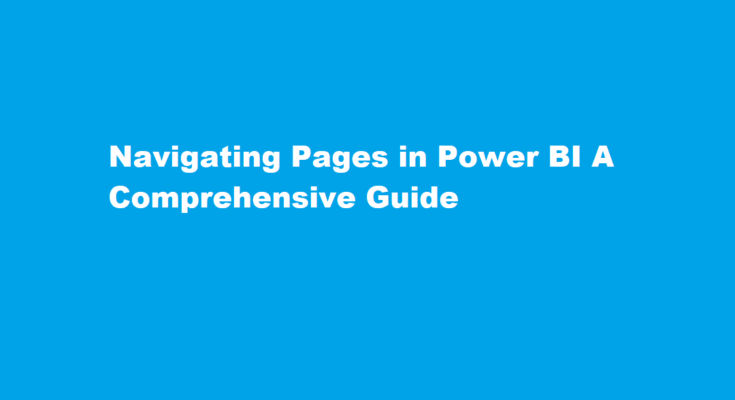Introduction
Power BI is a powerful data visualization and business intelligence tool that allows users to create interactive reports and dashboards. One essential feature of Power BI is the ability to create multiple pages within a report, enabling users to organize and present their data effectively. In this article, we will explore how to navigate pages in Power BI and make the most out of this feature.
Understanding Power BI Pages
Before we dive into the details of navigating pages, let’s understand what Power BI pages are. In Power BI, a page is a canvas where you can create visualizations, add charts, tables, and other elements to represent your data. Think of pages as individual slides in a presentation; you can use them to tell a story or convey specific information.
Creating Pages
To create a new page in Power BI, follow these simple steps
1. Open your Power BI report.
2. Click on the “Pages” pane on the left side of the screen.
3. Click the “+ New Page” button.
4. A blank canvas will appear where you can start designing your new page.
Once you’ve created your pages, it’s essential to know how to navigate between them seamlessly.
Navigating Pages in Power BI
Power BI provides several methods for navigating between pages, depending on your preference and the situation.
1. Page Navigation Pane – The Page Navigation Pane is located on the left side of the screen by default. It displays a list of all the pages in your report. You can click on a page’s name in the pane to quickly jump to that page.
2. Keyboard Shortcuts – Power BI offers keyboard shortcuts for page navigation. To navigate forward, press “Ctrl” + “Page Down,” and to navigate backward, press “Ctrl” + “Page Up.” These shortcuts are handy when you want to move quickly between pages during a presentation or while exploring your report.
3. Table of Contents – You can add a table of contents to your report to provide users with a visual menu for page navigation. To create a table of contents, insert a “Buttons” visual and link each button to a specific page in your report. This interactive approach allows users to click on the table of contents to move between pages easily.
4. Bookmarks – Bookmarks are a versatile feature in Power BI that not only help with page navigation but also enable you to save the current state of your report, including filters, selections, and page views. You can create bookmarks for each page and then use the “Selection Pane” to show or hide specific bookmarks. This method is especially useful when you want to create interactive experiences within your report.
5. Hyperlinks – Power BI allows you to add hyperlinks to text, images, or shapes. You can use this feature to create links between pages or even external websites. To do this, select the element you want to hyperlink, go to the “Format” pane, and enter the URL or choose the page you want to link to.
Best Practices for Page Navigation
To make your Power BI reports user-friendly and intuitive, consider these best practices for page navigation
1. Organize Content – Structure your report pages logically. Use clear page titles and arrange the pages in a sequence that tells a coherent story or guides users through specific insights.
2. Provide Context – Use tooltips or text boxes to provide context and instructions to users about the purpose of each page and how to navigate between them.
3. Use Visual Cues – Utilize icons, buttons, or images to visually indicate interactive elements that users can click on to navigate between pages.
4. Test User Experience – Before sharing your Power BI report, test the page navigation to ensure that it is intuitive and user-friendly. Ask for feedback from colleagues or end-users to make improvements.
Frequently Asked Questions
How do you navigate between pages in Power BI?
Click on the button on your first (landing) page and go down the Action selection. In the Destination drop-down, select the page you want to navigate to. On the destination page, do this same process with the navigation pointing back to your starting page.
How do I view pages in Power BI?
In Report view, select the View tab to open Page view settings as well as phone layout settings. In the Power BI service (app.powerbi.com), open a report, select Edit, then select View from the upper left menu bar.
Conclusion
Navigating pages in Power BI is a fundamental skill that enhances the usability and effectiveness of your reports and dashboards. By understanding the various methods available for page navigation and following best practices, you can create reports that not only showcase your data but also provide a seamless and engaging user experience. Whether you’re building reports for internal stakeholders or external clients, mastering page navigation in Power BI will help you convey your insights more effectively and make a lasting impact.
Read Also : Navigating Pages in Angular A Comprehensive Guide



